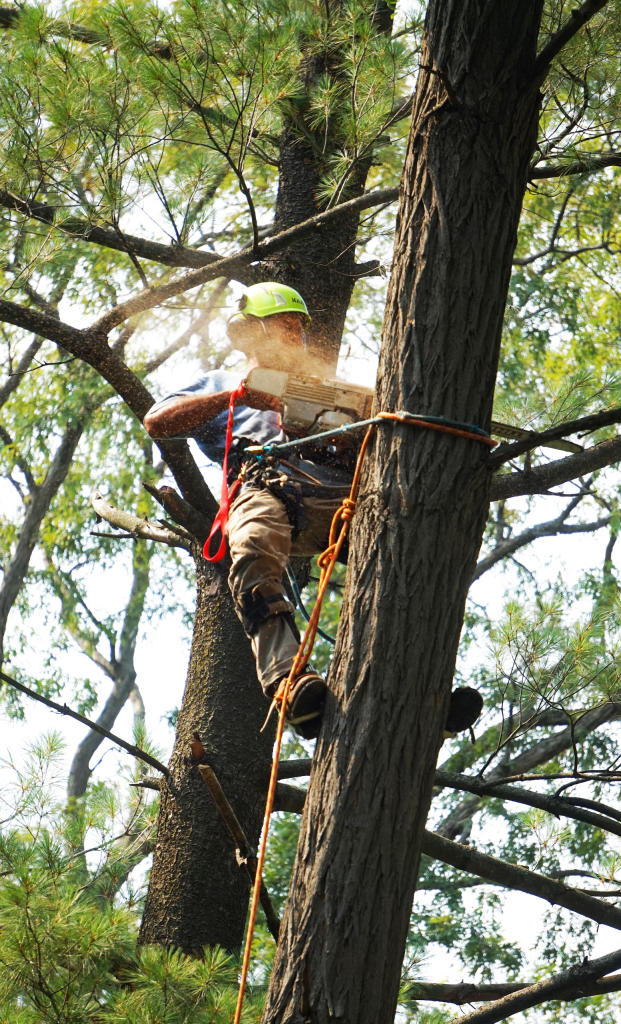There are no hard and fast requirements to become an arborist or tree surgeon, but due to the difficulty of the work, education and training are highly recommended.
To ensure the safety of trees, an arborist’s job entails regularly inspecting and treating them. Working as an arborist is both crucial and exciting now, as diseases like acute oak decline and ash dieback threaten Britain’s ancient species.

Although formal qualifications are not required, many of those working in the industry have extensive experience and expertise. Professional training is essential for this job because of the risks involved in working at height and with heavy machinery. Unskilled performance is not acceptable. There is no greater need for lifelong learning than in our field.
Tree removal may be what most people associate with arborists, but in reality, we often save trees and do good for the environment when we do so. Your education will also include learning how to correctly identify a tree, as well as its specific requirements and growing conditions.
What Is An Arborist?
It is the job of an arborist, or “tree surgeon,” to ensure the health and safety of a forest’s trees. Planting, trimming, fertilizing, and identifying and eradicating pests and diseases are all part of this process.
Arborists have undergone extensive education and training to learn about the anatomy and physiology of trees and the best practices for providing them with the care they need. They could be employed by a private firm, the government, or a utility company, or they could be self-employed. Some arborists offer advice to property owners and businesses on how to care for their trees in consultations.
How To Become An Arborist?
There are several steps you can take to become an arborist:
1. Earn A High School Diploma Or Equivalent.
To enter the field as an arborist, one must first complete high school or its equivalent. Having a high school diploma or its equivalent is helpful, but not required when looking for work as an arborist. Additionally, it can equip you with the foundational expertise required to continue your education and training in arboriculture or a related field.
2. Pursue A Degree In Arboriculture Or A Related Field.
Gaining knowledge of the biology, physiology, and management of trees, as well as developing hands-on skills like tree identification and pruning techniques, can be accomplished by earning a degree in arboriculture or a related field. Coursework in arboriculture and forestry degree programs may cover subjects like tree biology, tree care and maintenance, and tree identification.
Getting a degree can also make you more marketable to potential employers, increasing your chances of getting hired as an arborist. A degree may also help you become certified as an arborist because many programs have educational or experience requirements.
If you want to study arboriculture or a related field at university, you should look into the degree programs offered by local and online schools. Those interested in learning more about arboriculture-related educational opportunities may want to contact groups like the Tree Care Industry Association (TCIA) or the International Society of Arboriculture (ISA).
3. Gain Experience Working With Trees.
Getting your hands dirty pruning and trimming trees is a crucial experience for any aspiring arborist. Many arborists get their start as members of a tree climbing or ground crew and work their way up to more senior positions. Gaining practical experience by working as a tree climber or ground crew member and learning from more seasoned arborists is a great way to break into the field.
Learning about and working with trees can be done in several different ways:
Seek Out Internships Or Apprenticeships
Try to land an internship or apprenticeship with a company or group that deals with tree care. There are many opportunities to gain experience as an arborist through internships and apprenticeships.
Volunteer With A Tree Care Organization
Engage in tree maintenance by volunteering. You can get hands-on experience caring for trees by volunteering with an organization like a park district or a conservation group.
Take On Small Jobs Or Contracts On Your Own
Start by working solo on small projects or contracts. You may be able to take on small jobs or contracts on your own, such as pruning trees or removing small trees, if you have some basic knowledge and skills. Your resume will benefit from this, and you can gain valuable experience caring for trees at the same time.
Consider Joining A Tree Care Or Arboriculture Association
Join a group dedicated to tree care and arboriculture. You can learn new skills and meet potential employers through the many associations out there that provide educational and networking opportunities, as well as job boards and other useful resources.
Gaining practical experience in the field will allow you to hone your arboriculture expertise, broaden your knowledge base, and make valuable professional connections.
4. Obtain Certification.
Gaining arborist certification demonstrates your competence and is a good step toward a more senior position. The Tree Care Industry Association and the International Society of Arboriculture are just two of the many groups that offer arborists the opportunity to become certified in their field (TCIA).
Most certifications necessitate a certain level of education and work experience, in addition to a successful test score. You’ll need to show that you know your stuff when it comes to tree biology and care, and you’ll need to have a certain amount of education or experience in the field, depending on the certification program you choose.
If you’re looking to stand out from the competition and land a job as an arborist, getting certified can help. Certification shows employers that you’ve met rigorous standards and have extensive knowledge and experience in the field. Aside from that, some companies would rather hire certified arborists, while others might even require it.
If you’re thinking about getting certified, it’s a good idea to look into the various certification programs to find one that fits your needs and background the best. The next step toward certification is to complete any prerequisite coursework or work experience, then register for the exam and study for it.
5. Keep Up With Industry Developments.
To provide the best care for trees, arborists need to keep up with the latest developments in arboriculture, which is a rapidly developing field. Keeping abreast of developments in your field can also boost your employability and make you a better arborist.
If you want to keep up with the latest happenings in your field, you can do so in several different ways:
Participate In Continuing Education And Training Opportunities.
Take advantage of chances to further your education and skills. The International Society of Arboriculture (ISA) and the Tree Care Industry Association (TCIA) are just two of the many groups that provide arborists with opportunities to advance their education and expertise through training and workshops. Conferences, seminars, online classes, and workshops all fall into this category.
Join A Professional Association.
Participate in a relevant community by signing up with a group. The ISA and the TCIA are just two of the many professional organizations whose members have access to tools and events designed to keep them abreast of developments in their field. Newsletters, webinars, and other forms of online content creation and dissemination are examples.
Follow Industry Publications And Blogs.
Always keep up with the latest news and commentary in your field. The most recent advancements in arboriculture can be found discussed in a wide variety of periodicals and online blogs. These materials can be very helpful for learning about recent developments in the field, such as new methods, technologies, and scientific studies.
Stay Connected With Other Arborists.
Continue to network with other tree surgeons. Making connections with other arborists can be a great way to learn about new trends and share experiences in the field. You can do this in several ways, including by joining a professional organization, taking part in online discussion forums, or attending conferences and workshops.
Keeping abreast of recent happenings in the arboriculture field will help you develop as a professional and provide the best possible care for trees.
Conclusion
With dedication and hard work, you can make a successful career out of this rewarding profession. Don’t forget, a certified arborist is a highly trained professional who keeps trees healthy while respecting nature’s contribution to our environment – so don’t forget to enjoy the journey! Best of luck!
If you are looking for an arborist, click on tree cutters.
https://www.youtube.com/watch?v=axt2MkLp8A8&pp=ygUaSG93IFRvIEJlY29tZSBBbiBBcmJvcmlzdD8%3D

